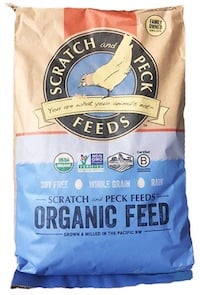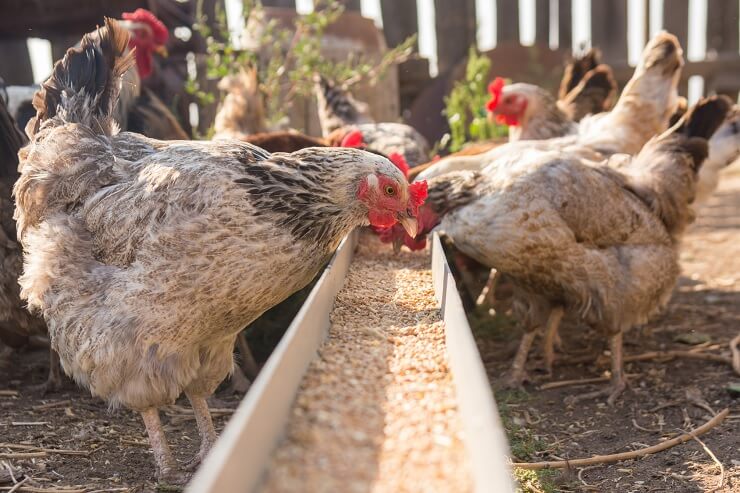What Age to Feed Chixkens Crackescorn
Have you fed your chickens some chicken scratch before? They love it.
They will come running when you shake that bag – but should they have it? Is it good for them? Do they need it?
We love to give our hens treats, but we need to remember that they need a properly balanced diet.
This article discusses everything you need to know about chicken scratch; the differences between chicken feed and scratch, whether or not your chickens should eat scratch, and much more.

Our Pick: Organic Scratch

Organic Scratch n' Corn Hen Treat
- Completely raw and unprocessed. Meaning, it keeps its optimal nutrition so your hens can better absorb critical vitamins.
- Sustainably farmed right here in the Pacific NW.
- This scratch is the only USDA-certified organic feed listed here.
See Price on Amazon
Chicken Scratch, What Is It?
So what is chicken scratch exactly?
As its name implies, it is something that chickens will scratch around in the dirt and bedding to find and eat.
It is a mixture of several seeds that chickens enjoy – much like bird food, only cheaper. The usual ingredients included in scratch are cracked or rolled corn, barley, oats, wheat, sunflower seeds, milo, and millet.
How much of each will depend on pricing. Scratch with a higher percentage of sunflower or milo seed will cost a bit more since these seed types are more expensive wholesale.
We have come to think of scratch as something 'ready-made' for us in feed bags, but it goes back much further than the advent of bagged feeds.
Back in the days before chickens had feed pellets and balanced nutrition, the farmers' wife may have thrown the excess or older seeds from a harvest and small kitchen scraps out to the chickens as a supplement to their meager diet – this was the likely origin of 'scratch.'
Chicken Scratch Review Table
Chicken Scratch VS Chicken Feed (What is the Difference)
As we all know, chicken feed is scientifically formulated to give chickens the exact amounts of nutrients they need based on their age and type (Chick vs. Hen or Egg Layer vs. Meat Bird).
For example, a 16% layer feed will give you 16% protein, the amount necessary for continued health and egg-laying. Fiber and fat content may vary a little based on the manufacturers' formulation.
In addition to corn, soybean, wheat, and alfalfa grains, feeds will contain a wide variety of trace elements such as selenium, copper sulfate, ferrous sulfate, and vital amino acids such as methionine.
You will also supplement them with a large variety of vitamins and, of course, calcium carbonate for shell making.
In these modern times, scratch is fed as a treat because it lacks sound, wholesome nutritional substance giving only 8-9% protein equivalency which is vastly inferior to the feed content.
Think of it this way:
- Chicken Feed = A Balanced Meal
- Chicken Scratch = French Fries and Soda
While we all love to indulge in special treats for ourselves and our animals, it should not become the mainstay of their (or our) diet.
Good balance to your hens' diet is essential if you want to keep them healthy and to lay.
If a hen has a diet that does not cover her nutritional needs, the first thing you'll notice is that she will stop spreading, or the eggs will be soft-shelled or shell-less.
The body will take all the nutrition it needs to maintain good health. If the diet is terrible, she will start to look tatty, dropping feathers (mini molts), dull eyes, depressed demeanor, and lack of energy.
So you can see that a balanced diet is a key to the health and welfare of your flock. By all means, give them treats if you want, but in small amounts and preferably not every day.
If you wish for specific information on feed formulations, see our article here.

Manna Pro Seven Grain Chicken Scratch
- This chicken scratch is grown and milled right here in the US.
- Contains no added artificial colors, gluten, or GMO products.
- Comes in a re-sealable pack to keep the grain fresh.
See Price on Amazon
How Much and How Often to Feed Chicken Scratch

Given that chicken scratch is a treat, you should follow this general rule on treats:
Any treats that you give your hens should not exceed 10% of their daily intake.
Well, how much is that, you ask?
A chicken's average food intake for a regular day is ½ cup chicken feed. A ½ cup contains 24 teaspoons of content, so 24 divided by 10 = 2.4 teaspoons of scratch per hen. That works out to a couple of beakfuls per hen.
Although it sounds like a small amount, their flockmate's pleasure, exercise, and companionship in the endeavor are probably all they need. They love nothing better than a good group bug or seed hunt!
If you have seeds left at the end of the scratch session, you are feeding too much, and excess sources lying on the floor will attract vermin and predators.
Feeding scratch is probably best in the evening to ensure that the birds get the bulk of their needed nutrition for the day.
In the initial stages of training birds to go to bed, you can use scratch to lure them into the coop at dusk. Once they get the idea of bedtime, you can withdraw the scratch if you want.
If you sprinkle it throughout the bedding, this will ensure the bedding is regularly turned over, and it gives the girls some exercise before roosting for the night.
When Should You Use Chicken Scratch?

I rarely use scratch anymore, looking at it as an unneeded expense, but there are times when the scratch is practical.
When you first get your chicks, crumble is an excellent tool for teaching them to trust you and associate you with good things (food). You can change over gradually to scratch as they get a bit bigger.
Training the hens to eat from your hand is accessible once they realize how good it is. It can also be used as a training 'reward' for good behavior or behavior modifications.
They all likely trained those chickens you see on YouTube performing tricks and navigating obstacle courses with scratch!
As we have already mentioned, getting them to return to the coop nightly is easier with a handful of scratch.
It can also be used as a reward for enduring an unpleasant but necessary treatment such as delousing. If your hen gets a reward for being good, she will come to you time and time again.
All these things encourage the birds to come to you, and they will learn you will not harm them.
In the winter months, giving some scratch before bedtime gives them a little boost of heat overnight. As they digest the grains, the extra heat generated keeps them just a bit warmer.
Chicken Scratch: Final Thoughts
You may be surprised to learn that not many 'old time' keepers use chicken scratch.
It is excellent as a training tool for backyard flocks in the 'honeymoon phase of your relationship and helps reward a bird for enduring something unpleasant.
If you are on a limited budget, do away with the scratch and buy a small bag of mid-priced birdseed.
This way, you can ensure the seed is relatively fresh and when you need to change for new, give it to the wild birds (well away from the chicken yard).
My girls usually get birdseed substitutes, and they haven't complained yet! Do you use scratch, make your own, substitute?
Let us know how you spoil your ladies in the comments section below.
Shop For Chicken Scratch on Amazon
Want To Share This…

Disclosure: We may earn affiliate commissions at no cost to you from the links on this page. This did not affect our assessment of products. Find full disclosure here.
Source: https://www.thehappychickencoop.com/chicken-scratch/
0 Response to "What Age to Feed Chixkens Crackescorn"
Post a Comment